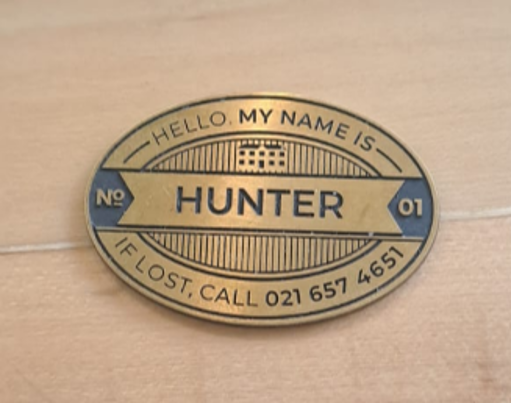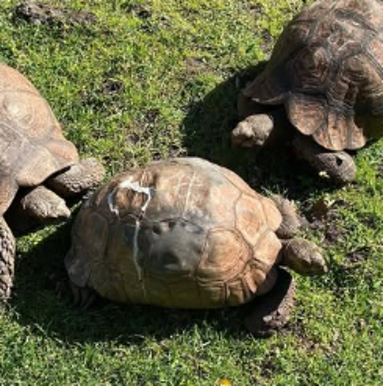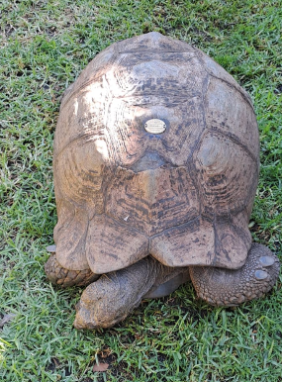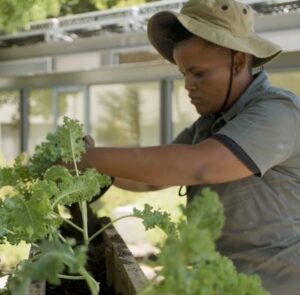Table of Contents
If you’ve landed on this post to have a quick skim before you hit the next thing and have to rush off —stop right there. Close the tab. Move along.
But if you’re ready to take some time to relax, sip your tea, and truly connect with us, this story is for you. Because today we’re taking a leaf (see what we did there?) from our resident Mountain Tortoises… and embracing the art of slowing down.
Tortoise time: the ultimate slowdown
Let’s talk about the Vineyard Hotel’s most famous residents—our fourteen numbered tortoises, some of whom have called our grounds home since the early 1980s. When you visit, you’re likely to meet them almost immediately, as they tend to stay close to the main hotel. (Watch this space for a tortoise scavenger hunt for the kids!)
Docile yet determined, our slow-moving stars always seem to find themselves in the spotlight, whether casually strolling through the grounds, following guests into the hotel corridor, or sneaking bites of hibiscus flowers.
Never ones to shy away from a money shot, our female tortoises often choose the front lawn as their seasonal nesting spot. It’s here they dig in to lay their eggs, giving us a beautiful display of nature at its finest.
Making life easier for our VIP residents
Our tortoises are adventurers at heart. They roam freely across our eight hectares of lush gardens, constantly surprising us with their exploration skills. They even “climb” stairs like seasoned pros! To make their journeys a little smoother (and more dignified), we’ve added little half steps to give them easier access across the bridge to their favourite grassy patch near our garden and river rooms.
When our tortoises decide they’d like to take a detour into the hotel, getting them back outside is no small feat! These heavy, determined explorers often need a little extra help. It can take more than one of our team members to coax them back to the gardens. But in true Vineyard Hotel style, we’re commissioning miniature baggage trolleys—just like the ones we use for guest luggage, but scaled down for our slower-moving residents. Think of it as their VIP transport for the ultimate tortoise roll-out!
Our tortoises also love to immerse themselves in the cool water of our fountains. But don’t drop your drink in panic! They’re not drowning, they’re just taking a well-deserved dip, enjoying the refreshing splash. After all, who wouldn’t want to unwind in style?
Our tortoises are tagged and ready to meet you!

To celebrate their presence (and, TBH, to tell the difference between them), we’ve had beautiful bronze tags handcrafted for each tortoise, displaying both their name and number. The numbering helps our vet identify them when they need care. Each tag has been securely affixed to their shell using non-toxic marine epoxy, the same material used to repair damaged shells.
We love having tortoises roaming through our gardens (and getting into all kinds of mischief), because in a world obsessed with ‘more’ and ‘faster’, these steady companions embody the hotel’s spirit, reminding us all to slow down and appreciate life’s simple moments.
And then, there’s the drama
You might be surprised to learn that behind those slow, steady movements lies a (sometimes scandalous) history of love, loss, and unexpected reunions.
Our eldest tortoises, Gloria (Number 4) and Tank (Number 2), are both around 50 years old and have been partners for decades. But it hasn’t always been smooth sailing and gentle grazing.
Back in 2003, Gloria’s former companion, Herbert, went missing just before Valentine’s Day, leaving her heartbroken. Had he disappeared forever? Or had he simply tired of domestic life and set off for an adventure on Table Mountain? Just when everyone assumed he was gone for good, Herbert made a dramatic return. He was found crossing a busy highway in Cape Town—completely unfazed by rush hour traffic. A local hero, having read about his disappearance in the newspaper, swooped in and saved him just in time.
Another drama took place during mating season, a time when tortoises transform into surprisingly speedy reptiles and can become a little too enthusiastic. Proving somewhat unlucky in love, Gloria once suffered a shell injury after a larger, over-amorous male tortoise pushed her off a ledge. Thankfully, Dr. Bebbington, the incredible vet from Blue Cross Vet Care, stepped in to nurse her back to health.


On the left is Gloria’s broken shell after her fall, which was fixed and is now secured with her name tag (right).
But despite the occasional saga, the tortoises’ overall approach to life offers a valuable lesson. Their ability to navigate life’s ups and downs at their own pace invites us to reconsider our own fast-paced lives.
Nature’s invitation to take it easy
We’re all so used to schedules, right? “Must-see this, must-do that.” Our minds are cluttered with to-do lists, deadlines, and the hustle. But what if you hit pause? What if you dropped all that for a bit and let the tortoises teach you how to slow down?
Our tortoises don’t care about your itinerary. They don’t care about your next Instagram post. They care about eating, basking, and moving—when they want to. Which, let’s be real, is exactly what all of us need to take note of.
When you arrive at The Vineyard Hotel, you’ll feel the unspoken invitation in the air to stop and truly look. There’s no rush. There’s nothing you have to do. So forget the schedule and reconnect. Just walk the grounds, watch the tortoises, and embrace the small things that are often drowned out by the noise of the everyday: the feel of grass underfoot, the smell of rain, the light shifting over Table Mountain.
And maybe, just maybe, you’ll return home with something unexpected: a newfound appreciation for the art of simply being.
After all, the tortoises have been doing it for decades. We should probably start following in their deliberate footsteps.
Get to know the Mountain Tortoise
The Mountain Tortoise is also known as the Leopard Tortoise, but we prefer the former for obvious reasons… (see our blog on Table Mountain).
Their shell is beautifully patterned with dark, irregular spots or streaks, which is how they got their “leopard” name. The patterns vary from tortoise to tortoise, giving each one a unique appearance.
Mountain tortoises are native to Southern and Eastern Africa, found in countries like South Africa, Namibia, Botswana, and parts of Zimbabwe. Although not typically found this low down in the Cape, they enjoy a variety of habitats, from Fynbos to thickets and Savannah to Thorn Scrub. Some have even been found 2900m above sea level (that’s three times the height of Table Mountain)!
These tortoises are among the largest in Africa. They can grow up to 50 cm in length and can weigh between 13-18 kg, with some individuals reaching up to 30 kg.
Mountain tortoises are primarily herbivores. They feed on a variety of grasses, leaves, fruits, and flowers. They also consume some succulents and cacti, using their strong jaws to break through tough plant material.
Tortoises are long-lived, often reaching 50-100 years of age in the wild, depending on environmental conditions and predation. In captivity, they can also live for many decades.
Females dig a hole in the ground to lay their eggs, which can be between 5 to 15 per clutch, depending on the size of the female. The eggs incubate in the warm earth for about 3 to 6 months before hatching.
While they are slow-moving animals, they are surprisingly capable of quick bursts of speed when necessary, especially when they feel threatened. Unlike many other tortoise species, Mountain Tortoises are quite social and may be seen foraging in small groups.
The Mountain Tortoise’s natural predators include jackals, birds of prey, and large carnivores. They rely on their hard, domed shell to protect themselves, and they are also known to bury themselves in the ground to hide from predators.
While they are desert-adapted animals, Mountain Tortoises require regular access to fresh water to remain hydrated, particularly in their hotter environments.
Respecting our tortoises
Our tortoises are special, but they’re also sensitive. A few important reminders when you meet them:
- No picking up – They can become dehydrated if handled.
- No sitting on them – Many can barely carry their own shells, let alone a human!
- No feeding – They might mistake your finger for a tasty flower.
- Respect their space – They hiss when disturbed and retract their limbs for protection
Take-A-Breather
Enjoy a peaceful getaway with our Best Available Rate. Stay between 27 March - 31 August 2025, for a minimum of 2 nights, including a Saturday, and immerse yourself in our renowned hospitality.
Learn MoreLearn More

















